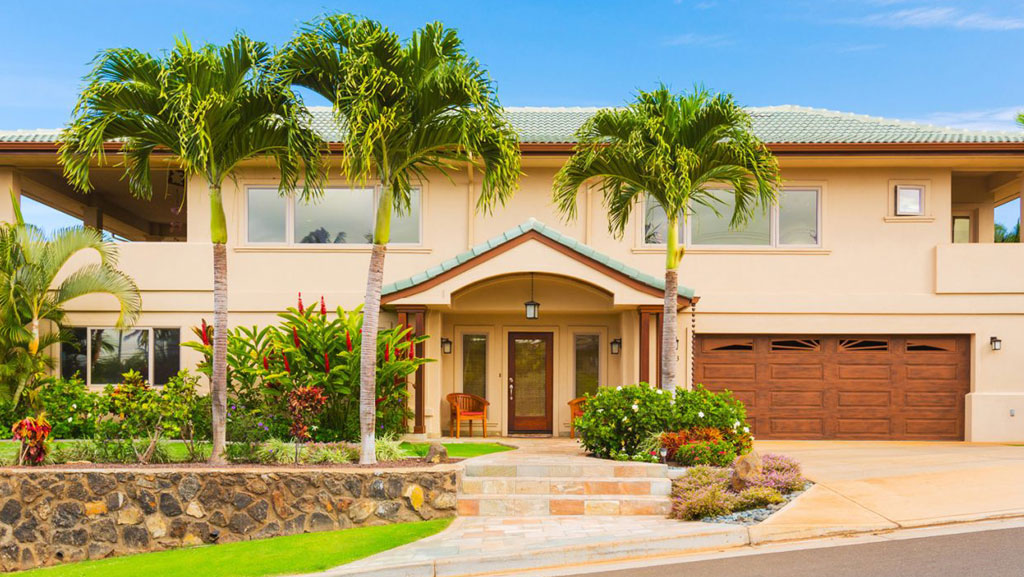Are primers becoming a thing of the past? The jury is still out
With the rapid technological advances in the paint industry and increased competition coupled with depressed markets, every manufacturer is desperate to bring to market as many of the most innovative products, as fast as possible. Some genuinely do so, others jump the bandwagon not to be left out, whilst still others pretend to do so. At the end of the day, it can all be very confusing to the homeowner and even the painter who have no idea what to do. Should the surface be primed and then paint or should they go for the recently promoted and seemingly easier all-in-one option?
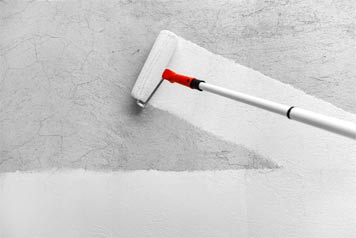
If one were to ask a painter, he’d probably sing in a loud chorus the praises of a “paint and primer in one.” No question about it! But what would his motives be for doing so? Some painters argue that all-in-one products simplify the process, reduce the time it takes to complete the job and most of all they reduce the cost of both paint and labour. This keeps the painter in the game to get the job against others who may be recommending the more costly time-consuming option. In addition the job is completed faster and allow the painter to move on to the next job more quickly. Sounds like music to the homeowner’s ears as well. Ideally he’s looking for the best products, at the lowest price, painted in the shortest time and with the least disruption. Sounds like a homeowner’s dream. But do these products really work? Are they on par in performance with the traditional system of primer plus 1 or 2 topcoats?
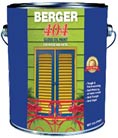
Premium Berger products such as Berger 404 and Berger 303 are self-priming; however Berger recommends priming before application of these topcoats, not because the company wants to sell products that consumers don’t need, but for the very reason of wanting the consumer to get maximum performance in their investment and enjoy the durability they expect from a Berger recommended painting system.
If we understand the myriad of problems solved by primers in the first place, we might get a better understanding of why companies like Berger would continue to recommend the use of primers in the painting system; and since primers exist to prepare the surface for top coats, it seems counterintuitive to think combined with paint, they are able to meet the different criteria of a primer, at the same time serve as a topcoat. At the end of the day, no one primer solves every problem. A primer that provides super adhesion may be poor at blocking stains, and a primer that provides blocking may be poor at solving chalking for example.
As the standard, Berger recommends the application of 1 primer coat + 2 topcoats. This system has been tried, tested and proven to be the best painting system for any new surface, and for other reasons as well; such as over-coating glossy, smooth surfaces, with a different sheen level, such as from a gloss or semi-gloss to a matt finish where the primer would provide sealing, adhesion and minimise the glare of the glossy coat. Another good reason is the increasing shift away from oil paint, where homeowners who would have painted in oil see the merit in shifting to equally comparable, water-based alternatives. Moving from oil paint with to water based acrylic will definitely require a primer as an intermediary tie-coat, to ensure adhesion. The primer sticks to the oil paint and the topcoat sticks to the primer, so that all three remain bonded together.
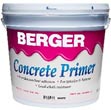
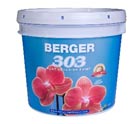
At first glance, applying primer may seem like an unnecessary expense. It creates an extra step, requires more material and increases the cost of the job, but in reality because of the long term durability this system costs, it saves money and time in the long run. A good coat of primer improves paint’s hide, or ability to cover, reducing the number of coats that are necessary to achieve a smooth finish. Primers can be tinted to match the paint colour. Tinting improves the primer’s hide and smooths the transition between primer and topcoat.
On the flip side, there are many instances where a primer or all-in-one would add no additional value and therefore not recommended; such as repainting in the same sheen level. As long as the surface is in good condition and any pre-existing surface problems resolved, there’s absolutely no reason to add the unnecessary step of applying a primer in this instance. So, is there room for compromise? Yes indeed there is!
All-in-one paint will work in some situations; e.g. where the homeowner is not seeking long term durability, simply because it’s either a yearly tradition or they quickly get bored with the colours and seek to change their colour scheme. Of course. there are the added benefits of reduced labour time and costs, especially if painting on an already painted surface which make this a good option to consider. If the latter is the case, the homeowner could simply purchase a value-for-money brand such as Magicote, where long term durability is not the consideration. Most premium brands offer both without being all-in-one and are less expensive.
Another good reason for using an all-in-one, would be over-painting a dark colour in a light shade. So there are circumstances where the all-in-one would be worth consideration. Conversely, new construction with bare sheetrock where the homeowner wants to paint white, would require a separate primer. Of course this would work well for most interior surfaces; but would the same apply to exterior surfaces?
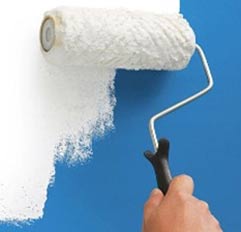
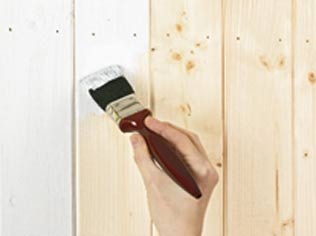
Another good reason for using an all-in-one, would be over-painting a dark colour in a light shade. So there are circumstances where the all-in-one would be worth consideration. Conversely, new construction with bare sheetrock where the homeowner wants to paint white, would require a separate primer. Of course this would work well for most interior surfaces; but would the same apply to exterior surfaces?
Let’s first examine the reasons why primers are used. These include sealing the pores and knots in wood and other permeable materials, water-marks and tobacco smoke. Primers also make topcoats go on more smoothly and minimise surface absorption, so that your paint would definitely look better and last longer too. Every new surface—wood, drywall, metal, and concrete—should be primed before painting. While it can be tempting to skip this step, the results could be disappointing. Paint applied to un-primed surfaces is more prone to cracking, peeling, flaking, and chalking compared to paint applied to properly primed surfaces.
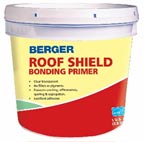 Primers also serve to provide a sound base on which to apply topcoats; such as with Berger Roof Shield Bonding Primer, which is made to stick equally well to metal, clay, concrete and wood. The topcoat, Roof Shield Waterproofing Coating would in turn need to provide a waterproofing barrier, but to stick to so many different surfaces as one product, would need the bonding primer to provide the foundation on which Roof Shield is expected to stick. In such cases, a primer cannot be substituted.
Primers also serve to provide a sound base on which to apply topcoats; such as with Berger Roof Shield Bonding Primer, which is made to stick equally well to metal, clay, concrete and wood. The topcoat, Roof Shield Waterproofing Coating would in turn need to provide a waterproofing barrier, but to stick to so many different surfaces as one product, would need the bonding primer to provide the foundation on which Roof Shield is expected to stick. In such cases, a primer cannot be substituted.
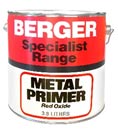 Since the purpose of primer it to protect the surface and provide adhesion to the paint layer, sacrificing either of these qualities especially in conditions as harsh as exist in the finish, but also with the long term-health of the substrate.
Since the purpose of primer it to protect the surface and provide adhesion to the paint layer, sacrificing either of these qualities especially in conditions as harsh as exist in the finish, but also with the long term-health of the substrate.
For professional painters, paint that includes primer should be used selectively. Whilst attempting to find the “best” at the lowest may yield short term savings in time and money, the compromise in opting for an all-in-one product could actually end up costing more down the road, in having to invest in time and materials to redo the paint job in a shorter time frame than anticipated.
When to Prime
Previously painted surfaces may not require priming unless you’re switching between oil-based or water based paint or the existing paint is failing. Always scrape and sand any deteriorating surfaces before applying primer. Remember, the durability and success of your paint job is highly dependent on the quality and level of preparation that goes into it.
One great development in the paint industry has been the introduction of water-based primers and topcoats made especially for wood and metal. This now allows switching from oil based coatings to water based which offer additional benefits not available in oil based products, such as low or virtually no odour, easy clean up in water, faster drying and recoating times, and a much shorter curing time as well. Caution; painting over multiple layers of oil-based paint on exterior surfaces with water based paint could cause adhesion problems. So unless you plan on removing the old oil-based layers of paint, Berger recommends that the surface be sanded, cleaned, prime or spot prime as required and continue top-coating with oil-based house paint.
Types of Primers
Berger primers are available in oil and water-based formulas. Each type has differing properties and uses a different solvent for thinning and clean-up. The primer to use would be determined by the needs of the project at hand.
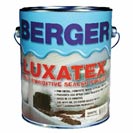 Oil primers are known for their smooth finish, ability to penetrate the wood grain by filling pores without raising the grain. This means that little or no sanding is required to achieve a smooth surface. In addition, oil-based primers function as barriers to keep tannins in certain woods from bleeding through the surface and making the paint job look ugly. Some primers like Berger Luxatex are formulated especially to block alkali salts from interacting with the topcoat, causing blotching.
Oil primers are known for their smooth finish, ability to penetrate the wood grain by filling pores without raising the grain. This means that little or no sanding is required to achieve a smooth surface. In addition, oil-based primers function as barriers to keep tannins in certain woods from bleeding through the surface and making the paint job look ugly. Some primers like Berger Luxatex are formulated especially to block alkali salts from interacting with the topcoat, causing blotching.
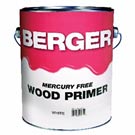 Oil-based primers are good to use for new and unfinished wood, previously varnished wood, weathered wood, and wood prone to weathering, to provide an extra wear-layer. In addition, oil primers are used over paint that is failing to solve surface problems such as chalking and cracking.
Oil-based primers are good to use for new and unfinished wood, previously varnished wood, weathered wood, and wood prone to weathering, to provide an extra wear-layer. In addition, oil primers are used over paint that is failing to solve surface problems such as chalking and cracking.
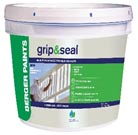 Water-based primers today are made to apply on multiple surfaces and are growing in preference because of their low odour, low-VOC formulations that make them environmentally friendly, whilst still providing a flexible, crack-resistant finish that is not as brittle as their oil-based primers. This makes them suitable for priming bare softwoods. The water in these primers however can cause the wood grain to swell and when raised could cause bleeding; so some sanding may be needed, not only to smoothen the surface but also to prevent bleed through.
Water-based primers today are made to apply on multiple surfaces and are growing in preference because of their low odour, low-VOC formulations that make them environmentally friendly, whilst still providing a flexible, crack-resistant finish that is not as brittle as their oil-based primers. This makes them suitable for priming bare softwoods. The water in these primers however can cause the wood grain to swell and when raised could cause bleeding; so some sanding may be needed, not only to smoothen the surface but also to prevent bleed through.
Water-based primers like Berger Grip&Seal are the best choice for drywall, since they act to even out the texture and sheen between the wallboard and joint compound. They also allow water vapour to pass through, and make the surface less prone to peeling. Use water-based primers on unfinished drywall, new softwoods like pine, concrete and brick and properly prepared metal, as some of these primers like Grip&Seal have anti-rust properties.
When asked, many homeowners often forget what was last used to paint their surfaces, whether it was oil-based or water-based. To verify this, wipe a small area with a clean rag saturated with denatured alcohol, paint de-glosser, or regular nail polish remover. If the paint is oil-based, it won’t be affected. If it’s water-based, some paint will come off on the rag or the surface may become tacky.
Application and Clean-up
Berger always recommends that before applying any primers, surface problems must be resolved and the surface should be dry, and free from grease, dirt, debris and any contaminants. It is a good idea to lightly sand the surface, after which it must be cleaned with a damp or tack rag and allowed to dry before applying primer. If the primer leaves the surface rough, lightly sand and dust it again before applying the finish coat. For best results, paint surfaces within a week after priming.
Follow the label directions for health and safety and always ensure adequate ventilation especially when using oil based primers. Basically, there should be no more of the fumes in the room than if you were priming on the outside. If opening the windows and using fans isn’t enough, wear an appropriate respirator. Remember that a dust mask is just what the name says. It will minimise dust but not block fumes. On interior surfaces with minimal ventilation, Berger recommends low odour, low VOC primers and paints.





